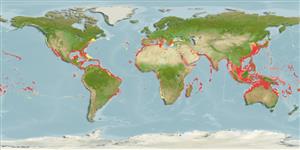>
Carangiformes (Jacks) >
Carangidae (Jacks and pompanos) > Naucratinae
Etymology: Seriola: Latin word diminutive with the meaning of a large earthenware pot (Ref. 45335).
More on author: Risso.
Environment: milieu / climate zone / depth range / distribution range
Οικολογία
Θαλασσινό(ά) Υφαλόφιλο(α); ωκεανόδρομο(ς) (Ref. 51243); εύρος βάθους 1 - 385 m (Ref. 11441), usually 18 - 72 m (Ref. 9626). Subtropical; 49°N - 36°S, 98°W - 128°E
Circumglobal. Tropical and warm temperate seas. Indo-West Pacific: South Africa, Persian Gulf, southern Japan and the Hawaiian Islands, south to New Caledonia; Mariana and Caroline islands in Micronesia. Western Atlantic: Bermuda (Ref. 26938), Nova Scotia, Canada to Brazil; also from the Gulf of Mexico and the Caribbean Sea (Ref. 9626). Eastern Atlantic: British coast (vagrant) to Morocco and the Mediterranean. Distribution in eastern central Atlantic along the African coast is not well established due to past confusion with Seriola carpenteri (Ref. 7097).
Length at first maturity / Μέγεθος / Βάρος / Age
Maturity: Lm 90.8, range 80 - 127 cm
Max length : 190 cm TL αρσενικό/απροσδιόριστο; (Ref. 3397); common length : 100.0 cm TL αρσενικό/απροσδιόριστο; (Ref. 3197); μεγ. δημοσιευμένο βάρος: 80.6 kg (Ref. 3287); μεγ. αναφερόμενη ηλικία: 15 έτη (Ref. 113943)
Ραχιαίες άκανθες (συνολικά): 8; Μαλακές ραχιαίες ακτίνες (συνολικά): 29-35; Εδρικές άκανθες 3; Μαλακές εδρικές ακτίνες: 18 - 22. Bluish grey or olivaceous above, silvery white below; amber stripe along midside of body; fins dusky (Ref. 3197). Second dorsal and anal fins with low anterior lobe (Ref. 26938). Species of Seriola lack scutes (Ref. 37816).
Adults found in deep seaward reefs; occasionally entering coastal bays. They feed primarily on fishes such as the bigeye scad, also on invertebrates (Ref. 4233). Small juveniles associate with floating plants or debris in oceanic and offshore waters. Juveniles form small schools or solitary (Ref. 5213). Eggs are pelagic (Ref. 4233). Utilized fresh and frozen; eaten pan-fried, broiled and baked (Ref. 9987). Reported to cause ciguatera in some areas (Ref. 26938).
Spawning happens during the summer, in areas near the coast. Embryo development lasts about 40 hours at 23° and larval development 31-36 days. Egg size 1.9 mm, larval at hatching 2.9 mm.
Paxton, J.R., D.F. Hoese, G.R. Allen and J.E. Hanley, 1989. Pisces. Petromyzontidae to Carangidae. Zoological Catalogue of Australia, Vol. 7. Australian Government Publishing Service, Canberra, 665 p. (Ref. 7300)
IUCN Red List Status (Ref. 130435)
Threat to humans
Reports of ciguatera poisoning
Human uses
αλιεία: περιορισμένης εμπορικότητας; Υδατοκαλλιέργειες: Εμπορικό(ά); αλιεία αναψυχής: ναί; Ενυδρείο: Δημόσια ενυδρεία
Εργαλεία
Special reports
Download XML
Διαδικτυακές πηγές
Estimates based on models
Preferred temperature (Ref.
123201): 16.9 - 29, mean 27.1 °C (based on 3486 cells).
Phylogenetic diversity index (Ref.
82804): PD
50 = 0.5020 [Uniqueness, from 0.5 = low to 2.0 = high].
Bayesian length-weight: a=0.01622 (0.01235 - 0.02130), b=2.92 (2.84 - 3.00), in cm total length, based on LWR estimates for this species (Ref.
93245).
Τροφικό Επίπεδο (Ref.
69278): 4.5 ±0.0 se; based on diet studies.
Generation time: 5.5 (3.9 - 5.8) years. Estimated as median ln(3)/K based on 11
growth studies.
Ελαστικότητα (Ref.
120179): Μεσαίο(α), ελάχιστος χρόνος για διπλασιασμό πληθυσμού 1,4 - 4,4 έτη (K=0.18; tm=4; tmax=15).
Prior r = 0.59, 95% CL = 0.39 - 0.89, Based on 4 stock assessments.
Fishing Vulnerability (Ref.
59153): Moderate to high vulnerability (54 of 100).
Climate Vulnerability (Ref.
125649): High vulnerability (62 of 100).
Nutrients (Ref.
124155): Calcium = 15 [7, 27] mg/100g; Iron = 0.641 [0.347, 1.180] mg/100g; Protein = 19.9 [16.9, 22.6] %; Omega3 = 0.238 [0.141, 0.418] g/100g; Selenium = 31.8 [16.4, 60.8] μg/100g; VitaminA = 62.5 [8.3, 430.9] μg/100g; Zinc = 0.351 [0.235, 0.528] mg/100g (wet weight); based on
nutrient studies.
